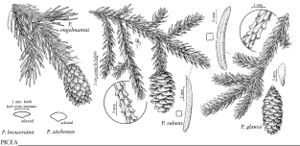Picea
Fl. Berlin 2: 794. 1824.
| Taxon | Illustrator ⠉ | |
|---|---|---|
 | Picea breweriana Picea engelmannii Picea rubens Picea glauca Picea sitchensis | John Myers John Myers John Myers John Myers John Myers |
Trees evergreen; crown broadly conic to spirelike; leading shoot erect. Bark gray to reddish-brown, thin and scaly (with thin plates), sometimes with resin blisters (especially in Picea engelmannii and P. glauca), becoming relatively thick and furrowed with age. Branches whorled; short (spur) shoots absent; twigs roughened by persistent leaf-bases. Buds ovoid, apex rounded to acute, sometimes resinous. Leaves borne singly, spreading in all directions from twigs, persisting to 10 years, mostly 4-angled and square in cross-section (to triangular or ± flattened), mostly rigid, sessile on peglike base; base decurrent, persistent after leaves shed, sheath absent; apex usually sharp-pointed, sometimes bluntly acute; resin canals 1–2. Cones borne on year-old twigs. Pollen cones grouped, axillary, oblong, yellow to purple. Seed-cones maturing in 1 season, usually shed at maturity (persisting for several years in Picea mariana), borne mostly on upper branches, pendent, ovoid to cylindric, sessile or terminal on leafy branchlets and thus appearing ± stalked; scales persistent, elliptic to fan-shaped, thin, lacking apophysis and umbo; bracts included. Seeds winged; cotyledons 5–15. x =12.
Distribution
North temperate regions, North America, Mexico, Eurasia
Discussion
Species ca. 35 (8 in the flora with 7 native and 1 naturalized).
Selected References
Lower Taxa
Key
| 1 | Leaves flattened or broadly triangular in cross section; stomates occurring only on, or more conspicuously on, adaxial leaf surface; Alaska to California. | > 2 |
| 1 | Leaves square in cross section; stomates occurring more or less equally on all leaf surfaces; widespread. | > 3 |
| 2 | Leaf apex sharp-pointed; twigs glabrous; seed-cone scales elliptic to narrowly diamond-shaped. | Picea sitchensis |
| 2 | Leaf apex blunt, especially on older leaves; twigs finely pubescent; seed-cone scales fan-shaped. | Picea breweriana |
| 3 | Twigs pubescent; cone scales usually fan-shaped, broadest near apex; seed cones 2.3-4.5(-5) cm; mostly eastern or boreal. | > 4 |
| 3 | Twigs mostly glabrous; cone scales usually ± diamond-shaped or elliptic, broadest near middle (broadest at apex in Picea glauca); seed cones (2.5-)3-16 cm; mostly western or boreal. | > 5 |
| 4 | Seed cones 1.5-2.5(-3.5) cm; leaves 0.6-1.5(-2) cm, mostly blunt-tipped, glaucous, blue- to gray-green. | Picea mariana |
| 4 | Seed cones 2.3-4.5(-5) cm; leaves 0.8-2.5(-3) cm, mostly acute, sharp-pointed, not glaucous, yellow-green to dark green. | Picea rubens |
| 5 | Seed cones (10-)12-16 cm; leaves 1-2.5 cm, blunt-tipped; introduced and locally naturalized species. | Picea abies |
| 5 | Seed cones 2.5-11(-12) cm; leaves (0.8-)1.2-3(-3.5) cm, mostly sharp-pointed; native species. | > 6 |
| 6 | Seed-cone scales fan-shaped, margin at apex q entire, apex extending 0.5-3 mm beyond seed-wing impression; leaves (0.8-)1.5-2(-2.5) cm. | Picea glauca |
| 6 | Seed-cone scales diamond-shaped or elliptic, margin at apex irregularly toothed to erose, apex usually extending 3 mm or more beyond seed-wing impression; leaves 1.2-3(-3.5) cm. | > 7 |
| 7 | Seed cones 3-7(-8) cm; cone scales extending 3-8 mm beyond seed-wing impression; twigs finely pubescent. | Picea engelmannii |
| 7 | Seed cones (5-)6-11(-12) cm; cone scales extending 8-10 mm beyond seed-wing impression; twigs usually glabrous. | Picea pungens |
"thin" is not a number.